Olfactory cues are sufficient to elicit social approach behaviors but not social transmission of food preference in C57BL/6J mice
- PMID: 18586054
- PMCID: PMC2630588
- DOI: 10.1016/j.bbr.2008.06.002
Olfactory cues are sufficient to elicit social approach behaviors but not social transmission of food preference in C57BL/6J mice
Abstract
Mouse models for the study of autistic-like behaviors are increasingly needed to test hypotheses about the causes of autism, and to evaluate potential treatments. Both the automated three-chambered social approach test and social transmission of food preference have been proposed as mouse behavioral assays with face validity to diagnostic symptoms of autism, including aberrant reciprocal social interactions and impaired communication. Both assays measure aspects of normal social behavior in the mouse. However, little is known regarding the salient cues present in each assay that elicit normal social approach and communication. To deconstruct the critical components, we focused on delivering discrete social and non-social olfactory and visual cues within the context of each assay. Results indicate that social olfactory cues were sufficient to elicit normal sociability in the three-chambered social approach test. On social transmission of food preference, isolated social olfactory cues were sufficient to induce social investigation, but not sufficient to induce food preference. These findings indicate that olfactory cues are important in mouse social interaction, but that additional sensory cues are necessary in certain situations. The present evidence that both the three-chambered social approach assay and the social transmission of food preference assay require socially relevant cues to elicit normal behavior supports the use of these two assays to investigate autism-related behavioral phenotypes in mice.
Figures
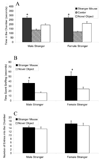
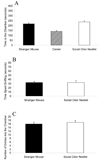
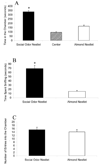
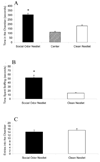
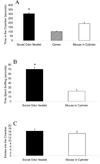
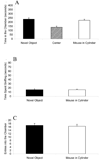
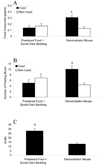
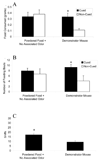
Similar articles
-
Mouse behavioral assays relevant to the symptoms of autism.Brain Pathol. 2007 Oct;17(4):448-59. doi: 10.1111/j.1750-3639.2007.00096.x. Brain Pathol. 2007. PMID: 17919130 Free PMC article. Review.
-
Development of a mouse test for repetitive, restricted behaviors: relevance to autism.Behav Brain Res. 2008 Mar 17;188(1):178-94. doi: 10.1016/j.bbr.2007.10.029. Epub 2007 Nov 4. Behav Brain Res. 2008. PMID: 18068825 Free PMC article.
-
Inbred strain preference in the BTBR T+ Itpr3tf /J mouse model of autism spectrum disorder: Does the stranger mouse matter in social approach?Autism Res. 2019 Aug;12(8):1184-1191. doi: 10.1002/aur.2158. Epub 2019 Jun 17. Autism Res. 2019. PMID: 31206258
-
Sociability and preference for social novelty in five inbred strains: an approach to assess autistic-like behavior in mice.Genes Brain Behav. 2004 Oct;3(5):287-302. doi: 10.1111/j.1601-1848.2004.00076.x. Genes Brain Behav. 2004. PMID: 15344922
-
Autism-like behavioral phenotypes in BTBR T+tf/J mice.Genes Brain Behav. 2008 Mar;7(2):152-63. doi: 10.1111/j.1601-183X.2007.00330.x. Epub 2007 Jun 7. Genes Brain Behav. 2008. PMID: 17559418
Cited by
-
Multiple autism-like behaviors in a novel transgenic mouse model.Behav Brain Res. 2011 Mar 17;218(1):29-41. doi: 10.1016/j.bbr.2010.11.026. Epub 2010 Nov 17. Behav Brain Res. 2011. PMID: 21093492 Free PMC article.
-
Eco-HAB as a fully automated and ecologically relevant assessment of social impairments in mouse models of autism.Elife. 2016 Oct 12;5:e19532. doi: 10.7554/eLife.19532. Elife. 2016. PMID: 27731798 Free PMC article.
-
Autism candidate gene DIP2A regulates spine morphogenesis via acetylation of cortactin.PLoS Biol. 2019 Oct 10;17(10):e3000461. doi: 10.1371/journal.pbio.3000461. eCollection 2019 Oct. PLoS Biol. 2019. PMID: 31600191 Free PMC article.
-
Sex- and age-dependent contribution of System xc- to cognitive, sensory, and social behaviors revealed by comprehensive behavioral analyses of System xc- null mice.Front Behav Neurosci. 2023 Aug 15;17:1238349. doi: 10.3389/fnbeh.2023.1238349. eCollection 2023. Front Behav Neurosci. 2023. PMID: 37649973 Free PMC article.
-
Translational animal models of autism and neurodevelopmental disorders.Dialogues Clin Neurosci. 2012 Sep;14(3):293-305. doi: 10.31887/DCNS.2012.14.3/jcrawley. Dialogues Clin Neurosci. 2012. PMID: 23226954 Free PMC article. Review.
References
-
- Ahl AS. The role of vibrissae in behavior: a status review. Vet Res Commun. 1986;10:245–268. - PubMed
-
- Alberts JR. Producing and interpreting experimental olfactory deficits. Physiol Behav. 1974;12:657–670. - PubMed
-
- Beauchamp GK, Yamazaki K. Chemical signaling in mice. Biochem Soc Trans. 2003;31:147–151. - PubMed
-
- Beauchamp GK, Yamazaki K. Individual differences and the chemical senses. Chem Senses. 2005;30 Suppl. 1:i6–i9. - PubMed
Publication types
MeSH terms
Grants and funding
LinkOut - more resources
Full Text Sources
Other Literature Sources

